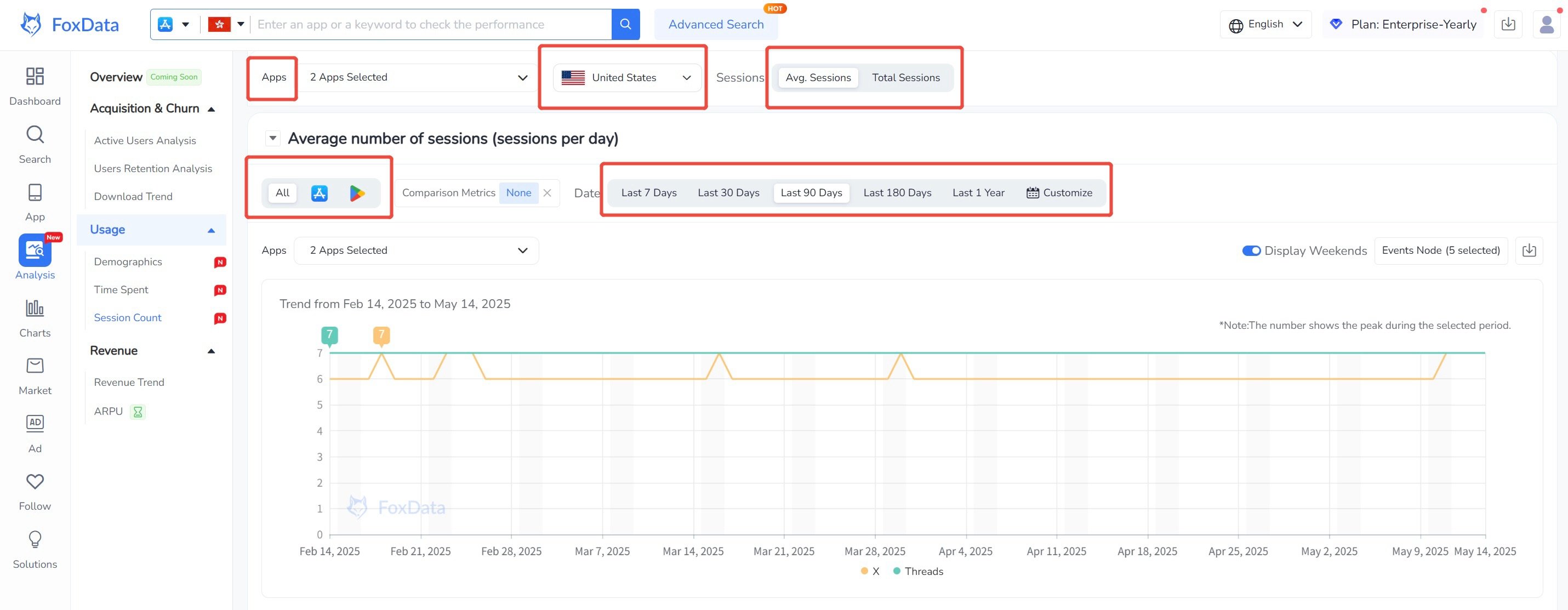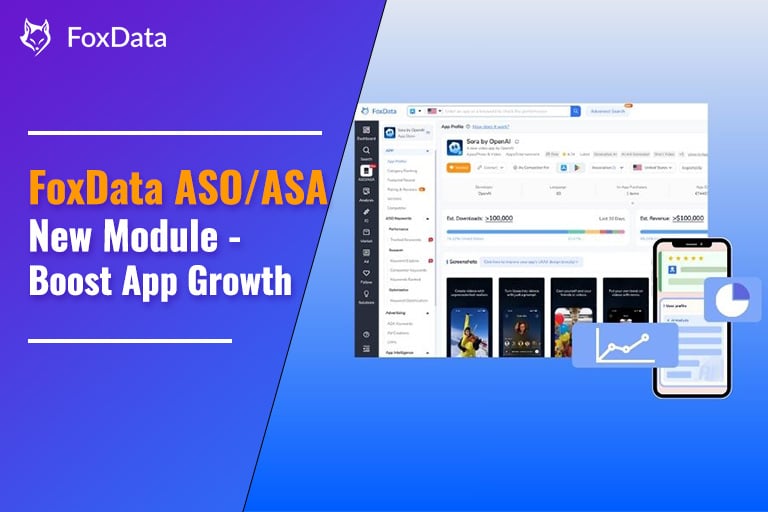Now Available | Unveil Your Users' Real Behavior With the Latest User Analytics Update
💡 Harness GameIQ deep game tags, global ad creative insights, precise download revenue predictions and player behavior analytics. Make every market decision backed by intelligence.
We address your challenges with tailored data-driven solutions for each pain point.
From insights to revenue, FoxData mobile game analytics solution integrates competitive intelligence, smart user acquisition, market predictions, and player value optimization.
Contact the FoxData Data Services Team
Do you truly understand your users?
In the intensely competitive app market, a primary challenge for developers is gaining precise insights into user behavior and profiles to inform product iterations and operational strategies.
Have you repeatedly asked yourself these questions?
- What are the primary demographics of my app users, including gender, age range, and geographic location?
- How frequently do users open the app daily, and what is their average session duration?
- During each session, how many interactions do they have, and what specific actions do they complete?
To assist developers in gaining a deeper understanding of user behavior, we are officially launching the "User Analysis Feature," which includes three core modules:
- Demographics
- Time Spent
- Session Count
Leveraging multi-dimensional behavioral data and visualized trend graphs, this feature will provide deeper insights for your product operation decisions.
Key Feature Highlights: Three core functions, all visible on one page
🔍 Demographics
- Gender Demographics: Pie chart illustrating the distribution of users by gender.
- Age Segmentation: Bar chart presenting the proportion of users in each age group.
- Regional Distribution: World map visualizing the proportion of "downloads + active users" by region.
- User Ratings: User satisfaction assessment based on app store review scores.
⏱️ Time Spent
- Daily average user session duration (including trend changes)
- Total daily user time
- Average session length
💬 Session Count
- Daily active user (DAU) session frequency
- Total session trend
- Usage frequency change trend (suitable for monitoring activity)
Feature Activation Guide: Step-by-step backend enablement
To quickly locate and enable the "User Analytics" feature, follow these steps:
【Analysis】 > 【Usage】>【Demographics】or 【Time Spent】or 【Session Count】
Within the user analysis section, you can navigate between views using three sub-modules, applying filters for time, region, and other criteria. Features include trend chart visualization, report exports, and version/channel comparisons to accommodate various needs.
Key Insights: What is the value derived from the data?
We aim to move beyond data collection, enabling actionable insights:
📊 Module 1: Demographics
Value Breakdown:
- Gender and Age Distribution: Segment user demographics to identify core audiences, thereby optimizing product content and ad campaigns.
- Regional Distribution Map: Identify key market opportunities; for example, rapid user growth in Southeast Asia could inform localization strategies.
- Rating Analysis: Assess regional rating trends to identify potential product experience issues related to cultural differences.
✅ Growth Tip:Prioritize operational efforts in high-rating, high-activity regions to drive regional viral growth.
⏱️ Module 2: Time Spent
Value Interpretation:
- Daily Average User Time + Total Usage Time Trends: Continuous decline indicates reduced user engagement; correlate with feature experience optimization.
- Average Session Duration: Measures "experience depth," particularly relevant for educational and content-based apps.
✅ Growth Tip: Decreasing user time isn't the issue; identify the cause—e.g., insufficient content update frequency, slow loading speeds?
💬 Module 3: Session Count
Value Interpretation:
- Daily Conversations: Reflects "usage frequency"; a key metric for measuring active users.
- Trend Fluctuation Chart: Assists in determining whether version iterations impact "open intent" (e.g., whether new features complicate processes, reducing return visits).
✅ Growth Tip: If a significant drop in daily conversations is observed, cross-reference with the 【Update Log】 timeline to quickly identify issues.
Case Study
Now let’s take Duolingo (an online language learning app) as an example to demonstrate our [User Analysis Function].
Background:
Duolingo launched a new event, "Stay Sharp with Math Games!" on March 10, 2025. The team anticipated this feature would boost user engagement and learning duration. However, within two weeks of the launch, the team observed a significant drop in overall user activity and session counts, leading to stagnant user growth.
Past Challenges:
The operations team recognized an issue but struggled to identify the "what" and "who" of the problem. Previously, they needed to analyze multiple tracking metrics simultaneously, which was time-consuming and didn't guarantee a solution.
Application of User Analysis, The team can take the following steps:
🔍 Step 1: Identify the Overall Downturn in User Behavior Trends
Navigate to the backend under [Usage] > [Time Spent], and select the "Compare one week before and after launch" timeframe:
Following the March 10th feature launch, average session duration increased by 9.12%, subsequently declining over time.
Total session count increased by 8.73%. Following a three-day stabilization period (March 10-12, 2025), total sessions gradually decreased.
🧠 Step 2: Analyze "Affected User Groups" and Usage Pattern Shifts
Within the[Demographics], filtering by dimensions such as gender, age, and country/region reveals:
* Duolingo's user base is predominantly female, accounting for approximately 67.63% of total users.
* The core user demographic is concentrated in the 25-35 age bracket (most significant), followed by the 18-25 age group.
* The top 5 usage regions are India, the United States, Brazil, Russia, and Mexico.
This indicates:
1️⃣ Gender Skew Towards Females ➜ Potential Content Affinity Issues
Duolingo's primary users are often casual learners, favoring language, cultural, and travel-related content. Math challenges may be perceived as "science-oriented," "logically demanding," and "serious," potentially conflicting with female users' preference for gamified, contextualized "light knowledge" content.
2️⃣ Core Age Group: 18-35 ➜ Focus on Efficiency and Outcomes, Reluctance to Deviate from Core Objectives
- These users prioritize practical goals such as "language skill applicability" and "career/study abroad advantages."
- The current math game training lacks strong integration with language learning outcomes (e.g., no direct improvement in TOEFL vocabulary or Japanese grammar), failing to provide a practical reinforcement pathway.
3️⃣ Regions Led by Emerging Markets (India, Brazil, etc.) ➜ Math Games Not a Primary Need
- Math games do not align with the initial motivations of users in these countries.
- Specifically, users in India and Mexico primarily use Duolingo to improve their English skills, not as a "logic game platform."
📉 Inference: The activity strategy does not align with the actual learning needs of the primary markets, resulting in a lack of regional enthusiasm.
📈 Step 3: How to optimize future strategies?
- Make the game content lighter and cuter: Use Duo mascot IP to create "Sudoku" puzzle games with a style close to the original user preferences.
- Regional differentiated delivery: Focus on pushing in countries with high perception of mathematics education such as China and the United States to increase the acceptance of gameplay.
- Community interaction: Guide users to challenge math games to hit the charts, and set medals to be common with language content to bind language learning goals.
FAQs: Questions you may want to ask about features
Q1: I see a decrease in user usage time in the trend chart. Does it mean that users don't like my product anymore? How can I determine where the problem lies?
A: Not necessarily. The decrease in usage time may be caused by multiple factors, such as functional changes, lower content update frequency, seasonal fluctuations during holidays, or even a smoother user behavior path leading to higher task completion efficiency.
We suggest you combine:
- Number of sessions (whether the opening frequency has also decreased)
- Single session duration (whether it exits after a short time)
- Version update log (whether there are major changes)
Analyze together to find the core problem.
Q2: What is the "regional distribution" data in the user portrait based on? Is it IP? Is it accurate?
A: Yes, the regional distribution data is mainly based on the user's IP location, and is combined with the device system language, time zone and other multi-dimensional comprehensive judgments to ensure that the display is relatively accurate and representative of the user's origin.
⚠️ It should be noted that the distribution of devices in some regions may be biased due to VPN, cloud proxy or special network environment (such as global universal ROM). It is recommended to make an overall judgment based on the mainstream user behavior data.
Q3: Can this data be embedded in my daily/weekly report?
A: Currently we support one-click export to Excel, so that your team can grasp the user dynamics at the first time without manually checking the data.
Q4: Where does the data come from? Is it accurate?
A: All data comes from cooperating third-party SDK tools, authorized user data, and large-scale model estimates. It is aggregated and calculated by the back-end and undergoes multiple layers of cleaning to ensure accuracy and timeliness.
Q5: Is there a tutorial on how to use the "User Analysis" function?
A: Yes, FoxData provides comprehensive tutorials and support documents to help you make full use of the "User Analysis" function. You can find them on FoxData Blogs or Help Center.
Q6: Which accounts can use the "User Analysis" function?
A: Currently, the [User Analysis] function is an exclusive function of FoxData Enterprise Edition, Optional modules can be purchased according to different needs.
If your product is undergoing a rapid iteration phase, or you want to make market judgments, user grouping and channel optimization with higher data sensitivity, then the Enterprise Edition will provide you with a complete and systematic user behavior analysis solution.
🎯Subscribe to the Enterprise Edition now >
Open full-link user insights to provide a more forward-looking decision-making basis for product growth.
Connect data and growth to understand the driving factors behind user behavior
Users will not tell you directly where the problem is, but their stay time, active curve and usage frequency will.
FoxData[User Analysis]module helps product teams interpret motivations from behavior, improve product decision-making efficiency and user conversion level.
Try FoxData now to build a more sustainable product growth strategy.








